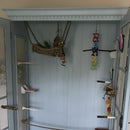Introduction: Practice Fire / Contact Staff - Cheap and Easy
Hello there.
So I wanted to learn how to spin a Fire Staff and/or do Contact manipulation of a staff. But I did not want to invest a lot of money until I knew I was going to like it.
Searching the internet and instructables yielded many results on making staff out of aluminum rods, shower curtain rods and wood dowels. But those items tend to be:
a) expensive
b) hard to come by
c) too heavy and
d) hurts a LOT when it hits you in the face.
So I went to my local H*** Despot and Wally-Market and picked up supplies to make a PVC Practice Fire / Contact Staff.
Total Cost: Less than $20.
End Result: Staff that does not hurt me (much) as I learn to spin.
Please Note: At NO point should this practice staff be set on fire!
Step 1: Parts List and Tools
Parts
1/2" - 1" Schedule 40 PVC pipe. 10 ft is $2.00
Foam exercise mat or camping mat - $6
Role of duct tape. $4
Really big nails: $1
Contact cement: $3
Tennis racket grip tape. $4
Tools
Hack saw
Scissors
Sharpie
Ruler
Step 2: Cut to Length
I read staff length can be 2, 3, or 4 feet. I read someplace else that the staff should go from floor to mid-sternum. Then there is the physics of it, Fast spinners want the staff short, slow spinners want the staff long.
I went for the mid-sternum method. And it just so happens to be 4 feet. And at $2 for 10 ft of PVC pipe, I have enough to make two more that are 3 ft each.
I went back to the hardware store and purchased another 10 ft length of pvc and made another staff 3ft 4in. So I have a full range of staffs.
Mark the length you need with sharpie and cut with your hack saw.
Step 3: Weigh the Ends
We want to add mass to the ends of the staff. A real fire staff is made of aluminim with a large wad of kevlar on the ends. the Kevlar is then soaked in fuel. We need to simulate all this weight and when we do we want all the weight at the ends of the staff. Mass at the ends provides momentum to cary out the spins. We will use large nails to add the mass at the ends.
Get the nail and wrap a little bit of duct tape on the ends. wrap just enough duct tape to make the nail fit snugly into the pipe. This is not for keeping the nail in. This is just to keep the nail from rattling in the pipe.
Insert the nails into the each end of the pipe.
Step 4: Cut Foam and Glue on the Pipe
Cut a section of foam that will wrap around the end of the pipe. Make it wide enough to approximate the kevlar wick. Since I have never seen a staff in real life I just guessed.
Put contact cement on the end of the pipe. Apply contact cement to one side of the foam. Carefully align the end of the foam to the PVC pipe and wrap the foam around the pipe.
Repeat on the other side of the pipe.
Step 5: Wrap Ends With Duct Tape
Seal the end with duct tape. Start with 3-4 layers over the nail. This is what will keep the nail in place.
Next , wrap the foam in duct tape. This will make the ends more durable.
repeat on the other end.
Make sure to use the same amount of tape on each side. We want to keep the staff balanced.
Step 6: Add Grip Tape
I went to wally-market and got some tennis racket grip tape.
I marked the center of the staff. then made sure the staff is balanced. If it is not balanced, add more layers of duct tape on the side that is light.
From the center I started wraping the grip tape towards the end following the instructions on the packaging. Flipped the staff over and wrapped more grip tape on the other half of the staff. I made sure the tape covers equal amounts of the staff on each half.
All done.
The staff is heavy enough on the ends that I get good momentum. It is a lot more forgiving than an aluminum staff or a wooden staff. I have smacked myself with it a few times already where a wooden staff would have probably given me a serious bruise. I have dropped it while it was in a high speed spin where an aluminum staff may have bent but this staff just bounced.

Participated in the
Make It Stick Contest 2













